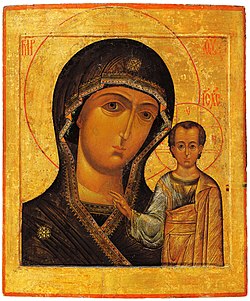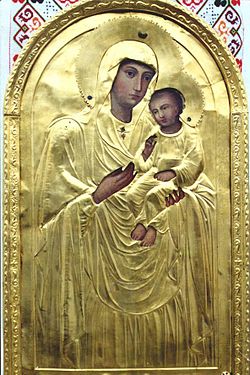Top Qs
Timeline
Chat
Perspective
July 8 (Eastern Orthodox liturgics)
Day in the Eastern Orthodox liturgical calendar From Wikipedia, the free encyclopedia
Remove ads
July 7 - Eastern Orthodox Church calendar - July 9

All fixed commemorations below are celebrated on July 21 by Old Calendar.[note 1]
For July 8th, Orthodox Churches on the Old Calendar commemorate the Saints listed on June 25.
Saints
- Hieromartyr Epictetus, Priest, and Monk-martyr Astion, at Halmyris in Scythia Minor (Romania) (290)[1][2][3]
- Great-martyr Procopius of Caesarea in Palestine, and with him (303):[1][4][5][6][7][8][note 2][note 3]
Remove ads
Pre-Schism Western saints
- Saints Aquila and Priscilla, a Christian missionary married couple described in the New Testament (Acts 18:3, Rom. 16:3-4) (1st century)[15][16][note 4][note 5] (see also: February 13, July 14)
- Saint Auspicius of Trier, the fourth Bishop of Trier in Germany and successor of St Maternus (c. 130)[15]
- Saint Apollonius, Bishop of Benevento in Italy (c. 326)[15][note 6][note 7]
- Saints Sostratus, Spirus, Eraclius, Eperentius and Cecilia, martyrs of Syrmium in Pannonia (4th century)
- Saint Morwenna, patroness of Morwenstow, England (5th or 6th century)[15][note 8] (see also July 5 )
- Saint Urith of Chittlehampton (Hieritha), a nun martyred by pagan English invaders at Chittlehampton in Devon (6th century?)[3][15][note 9]
- Saints Kilian (Chilianus), Colman and Totnan, monks from Ireland, Enlighteners of Franconia and East Thuringia, where they were martyred (c. 689)[15][17][18][note 10][note 11]
- Saint Landrada of Austrasia, foundress and first Abbess of Munsterbilsen in Belgium (c. 690)[15][19]
- Saint Withburgh of East Anglia (Withburga), an anchoress at East Dereham, Norfolk, England (c. 743)[7][15][20][note 12]
- Saint Arnold of Arnoldsweiler, a charitable Greek musician at the court of Charlemagne (c. 800)[15][note 13][note 14]
- Blessed Edgar the Peaceful, King of Mercia and Northumbria, and upon the death of his brother Eadwig (A.D. 959), King of all England (975)[1][3][15][21][22][note 15]
- Saint Grimbald, monk at St. Bertin Abbey in Saint-Omer in Flanders, invited by King Alfred the Great to help restore scholarship in England, Abbot of Winchester(901)[3][15][23][24]
- Virgin-martyr Sunniva (Sunnifa) and companions, on Selje Island, Norway (10th century)[1][7][15][25][26][note 16]
Remove ads
Post-Schism Orthodox saints
- Saint Procopius of Ustyug, Fool-for-Christ, Wonderworker of Ustiug, Vologda (1303)[1][3][5][27][28][29]
- Venerable Theophilus the Myrrh-gusher of Pantocrator Monastery on Mount Athos (1548)[1][3][5][7][30][31][note 17]
- Righteous Procopius, Fool-for-Christ, of Ustya, Vologda (c. 1600)[1][3][7][29][32][note 18]
- New Hieromartyr Anastasius of Saint Blaise in Hegumenitsa, Priest, of Constantinople (1743)[1][3][5][7][33][34]
New martyrs and confessors
Icons
- Miracle of the Annunciation Icon of the Mother of God at Ustiug (1290)[3][36][37]
- Appearance of the Kazan Icon of the Most Holy Theotokos (1579)[1][3][7][38][39]
- Reverence list of a "Kazan" Icon of the Most Holy Theotokos, at:[3][29]
- Kazan (1579)
- "Yaroslavl" (1588)
- Moscow (1612)
- "Viazniky" (1624)
- Nizhnelomovskaya (1643)
- Vitebsk (1655)
- "Tobolsk" (1661)
- "Kaplunovka" (1689)
- "Tambov" (1695)[40]
- Shlisselburg (1702)
- "Penza" (1717) (see also: August 4)
- Petersburg (1721)
- "Peschanka" / "Peschanskaya" (1754)[1][note 20]
- "Chimeev" (1770)
- "Vysochinovsky" (18th century)
- "Vyshensky" (1812)
Remove ads
Other commemorations
- Translation of the relics (1779) of St. Demetrius of Basarabov, Bulgaria, to Bucharest (1685)[1][3]
- Slaying of Anastasia Strogilos on the Mount of Olives (1995)[1]
- Synaxis of All Military Saints of the Orthodox Church (2019)[43][44][note 21]
Icon gallery
- Great-martyr Procopius of Caesarea in Palestine.
- St. Urith of Chittlehampton's (Hieritha's) tomb.
- St. Withburgh of East Anglia.
- St. Arnold of Arnoldsweiler (Coat of arms of Arnoldsweiler).
- Blessed Edgar the Peaceful.
- St. Procopius of Ustyug.
- Righteous Procopius, Fool-for-Christ, of Ustya.
- Kazan Icon of the Most Holy Theotokos, copy in the museum of Rostov Kremlin
- Icon of the Most Holy Theotokos Peschanskaya.
- Four Military Saints by Michael Damaskinos, showing St George and St Theodore Teron on the left, and St Demetrios and St Theodore Stratelates on the right.
Remove ads
Notes
- The notation Old Style or (OS) is sometimes used to indicate a date in the Julian Calendar (which is used by churches on the "Old Calendar").
The notation New Style or (NS), indicates a date in the Revised Julian calendar (which is used by churches on the "New Calendar"). - "Husband and wife, belonging to the Jewish diaspora, who worked as tentmakers at Rome and were exiled from there with all the other Jews under Claudius. They settled in Corinth, where they received the Apostle Paul into their house (Acts 18,3). Under Nero they returned to Rome and Paul sent greetings to them. A tradition in Rome says that they were martyred there."[15] Saint Aquila was Bishop of Heraclea, preached the word of God in Asia Minor and Achaia, and was killed by unbelievers.
- He went into hiding during the last persecution under Diocletian.
- See also: (in Italian) Apollonio di Benevento. Wikipedia. (Italian Wikipedia).
- Several places are named after her, notably Morwenstow in Cornwall, where her relics are probably buried under the church floor and where she has appeared. She is often confused with St. Modwenna (July 5th), who lived two centuries later.
- Her shrine was in the village church there, where her relics may still be buried under the floor.
- Kilian was Bishop of Wurzburg in Germany where he is still honoured.
- Youngest daughter of King Anna of East Anglia in England. After her father had fallen in battle, she became a nun and lived as an anchoress at East Dereham in Norfolk, founding a convent there.
- Apparently of Greek descent, he was famed for his charity to the poor. He has left his name to the village, Arnold-Villiers (Arnoldsweiler) near Jülich, now in Germany.
- See also: (in German) Arnold von Arnoldsweiler.
- A King of England who repented of a depraved youth and whose reign was marked by a strong religious revival in England.
- By tradition, Sunniva was a princess who fled from Ireland with her brother and others. They were shipwrecked off the coast of Norway but landed on Selje Island. Here they were slain by people from the mainland and their relics were enshrined in Bergen.
- See: (in Russian) Прокопий Устьянский. Википедии. (Russian Wikipedia).
- See: (in Russian) Прокопий (Титов). Википедии. (Russian Wikipedia).
- See: (in Russian) Песчанская икона Божией Матери. Википедии. (Russian Wikipedia).
- On Mount Athos the Synaxis of All Military Saints is celebrated on May 24th, and there is a Divine Office composed for this feast.
Remove ads
References
Sources
Wikiwand - on
Seamless Wikipedia browsing. On steroids.
Remove ads











